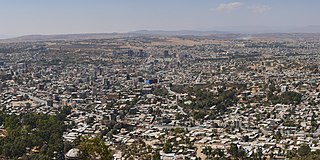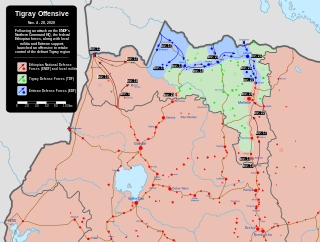
The Ethiopian National Defense Force (ENDF) is the combined military force of Ethiopia. ENDF is consisted of 10 command forces which is controlled by the Chief of General Staff.

The Tigray Region is the northernmost regional state in Ethiopia. The Tigray Region is the homeland of the Tigrayan, Irob and Kunama people. Its capital and largest city is Mekelle. Tigray is the fifth-largest by area, the fourth-most populous, and the fifth-most densely populated of the 11 regional states.

Adwa is a town and separate woreda in Tigray Region, Ethiopia. It is best known as the community closest to the site of the 1896 Battle of Adwa, in which Ethiopian soldiers defeated Italian troops, thus being one of the few African nations to thwart European colonialism. Located in the Central Zone of the Tigray Region, Adwa has a longitude and latitude of 14°10′N38°54′E, and an elevation of 1907 meters. Adwa is surrounded by Adwa woreda.

Mekelle, or Mek'ele, is a special zone and capital of the Tigray Region of Ethiopia. Mekelle was formerly the capital of Enderta awraja in Tigray. It is located around 780 kilometres (480 mi) north of the Ethiopian capital Addis Ababa, with an elevation of 2,254 metres (7,395 ft) above sea level. Administratively, Mekelle is considered a Special Zone, which is divided into seven sub-cities. It is the economic, cultural, and political hub of northern Ethiopia.

Shire, also known as Shire Inda Selassie, is a city and separate woreda in the Tigray Region of Ethiopia. The city is the administrative center of the Shire Awraja, Mi erabawi Zoba and now Semien Mi'irabawi Zone. It was part of Tahtay Koraro district.

The Eritrean War of Independence was an armed conflict and insurgency aimed at achieving self-determination and independence for Eritrea from Ethiopian rule. Starting in 1961, Eritrean insurgents engaged in guerrilla warfare to liberate Eritrea Province from the control of the Ethiopian Empire under Haile Selassie and later the Derg under Mengistu. Their efforts ultimately succeeded in 1991 with the fall of the Derg regime.
Tigray Province, also known as Tigre, was a historical province of northern Ethiopia that overlayed the present day Afar and Tigray regions. Akele Guzai borders with the Tigray province. It encompassed most of the territories of Tigrinya-speakers in Ethiopia. Tigray was separated from the northern Tigrinya speaking territories by the Mareb River, now serving as the state border to Eritrea, bordering Amhara region in the south.

The Tigrayan people are a Semitic-speaking ethnic group indigenous to the Tigray Region of northern Ethiopia. They speak the Tigrinya language, an Afroasiatic language belonging to the Ethiopian Semitic branch.
The Battle of Afabet was a three-day battle fought from 17 March through 20 March 1988 in and around the town of Afabet, as part of the Eritrean War of Independence. The battle has been described as being the largest battle in Africa since the Second Battle of El Alamein. It has been described as the most significant battle in terms of military and political consequences since the Ethio-Somali War, alongside the 1989 Battle of Shire of the Ethiopian Civil War.
Sheraro is a town and separate woreda in Tigray, Ethiopia. It is located in the North Western Zone of the Tigray Region, at an elevation of 1246 meters above sea level. It is the administrative center of Tahtay Adiyabo. It is near the border with Eritrea.
Enderta or Inderta is a former historical province of Ethiopia; it is located in the eastern edge of the Tigray highlands. Enderta is bordered on the west by Tembien, on the south and southwest by Lasta and Wag, on the east by denkel, and on the north by Agame and Adwa. Mekelle was formerly the capital of the province. Enderta's local administration of Denkel/Afar up to the edges of Aseb under its jurisdiction seems to have been highly, interlinked with the operation of the salt trade and its taxation system; the entire tasks of salt caravan organization being the responsibility of the bäalgada, title assumed by the governor of Endärta, since at least the Medieval period.

The Woyane rebellion was an uprising in the Tigray Province, Ethiopia against the centralization process from the government of Emperor Haile Selassie which took place in May–November 1943. The rebels called themselves the Woyane, a name borrowed from a game played locally between competing groups of young men from different villages, which connoted a spirit of resistance and unity. After nearly succeeding in overrunning the whole province, the rebels were defeated with the support of aircraft from the United Kingdom's Royal Air Force. Out of all the rebellions that engulfed Ethiopia during Haile Selassie's rule, this was the most serious internal threat that he faced.

The Mekelle offensive was a military campaign fought at the start of the Tigray War between the national armed forces of Ethiopia and the Tigray Region. The Ethiopian National Defense Force (ENDF) launched an offensive aimed at seizing the Tigray Peoples Liberation Front (TPLF) controlled regional capital of Mekelle starting on 17 November 2020.
This timeline of the Tigray War is part of a chronology of the military engagements of the Tigray War, a civil war that began in the Tigray Region of Ethiopia in early November 2020.
The Ethiopian Army is the land service branch of the Ethiopian National Defense Force. It is the senior of the two uniformed military branches. The force engages in land warfare and combined arms operations, including armored and mechanized operations as well as air assault operations.
Operation Alula Aba Nega, commonly shortened to Operation Alula, was a counter-offensive during the Tigray War by the Tigray Defense Forces against the Ethiopian military and its allies in Tigray. The operation was named after Ethiopian general Ras Alula Aba Nega, who was of Tigrayan descent. The offensive was launched on 11 June 2021 and recaptured vast swaths of territory across central and eastern Tigray, including the regional capital of Mekelle.

The Somali invasion of Ogaden took place in July 1977, when Somalia attacked Ethiopia in two formations. The main force had the aim of seizing Jijiga, Harar and Dire Dawa while a secondary force assaulted Dolo, Gode and Imi. The Somali National Army (SNA) committed to invade the Ogaden on 12 July 1977, according to Ethiopian Ministry of National Defense documents.
This Timeline of the Tigray War is part of a chronology of the military engagements of the Tigray War, a civil war that began in the Tigray Region of Ethiopia in early November 2020.
The 103rd Commando Division were the special forces of the Ethiopian Ground Forces under the People's Democratic Republic of Ethiopia. It was activated and began training in January 1987. It was part of the 604th Corps and was described as "the cream of the Ethiopian Army".
The siege of Nakfa took place in 1977 in and around the town of Nakfa in western Eritrea. It was laid to siege by the Eritrean People's Liberation Front (EPLF) against a small isolated Ethiopian battalion.









